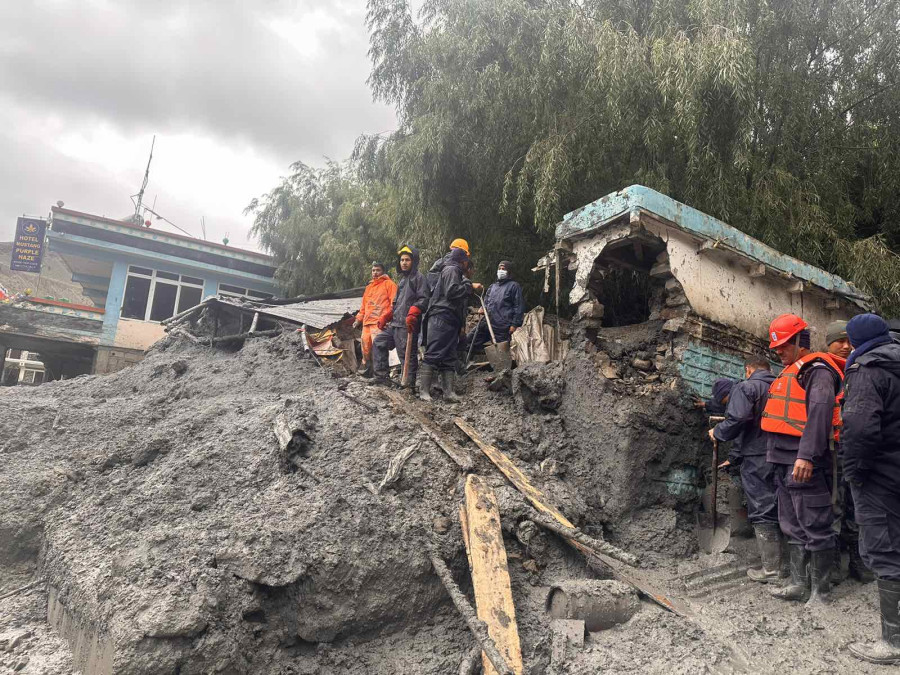Columns
Climate risks in the Himalayas
While the locals do not grasp the jargon of climate change, they feel its impacts daily.
Sanot Adhikari & Sweccha Raut
On August 13, floods in Kagbeni, Mustang, swept 30 houses and damaged 20 houses away. Heavy rains upstream had caused flash floods and landslides, surging mud into the Kag River and breaching the banks. Notably, the higher-altitude stations in Jomsom and Chhoser recorded 25.4 mm and 20.1 mm of rain, respectively, on that day, which is significant considering Mustang's average of 43.9 mm in the whole month of August. Such flooding events are increasing in frequency and severity, posing a growing danger. The question remains: What factors contribute to these extraordinary events?
As global temperatures rise, Nepal becomes more vulnerable to climate-related natural disasters, especially in the Himalayan region. From 2016 to 2045, moderate emissions suggest a 0.9°C temperature increase. Monsoon rains could triple, while winters might be dry. The Himalayas warm 0.3°C to 0.7°C faster than the global average, heightening Nepal's susceptibility towards speeding glacial meltdowns, lowering snow lines and raising flood risks. The International Finance Corporation warns that those threatened by climate-induced river floods in Nepal could increase from 157,000 (2010) to 350,000 by 2030. Over 80 percent of property losses come from climate-driven hazards like floods, landslides and glacial lake outbursts.
Changing landscapes
Research confirms the growing vulnerability of regions like Manang, Mustang and Lamjung owing to climate change. Moreover, Manang faces faster minimum temperature reduction and higher maximum temperatures, exposing residents to extreme cold and heat. Scientific analysis reveals a three-degree Celsius rise in Manang's average high temperature over 35 years. The escalating permafrost thaw, a direct consequence of rising temperatures, has weakened soil in the Himalayan realm. The hazard of debris flows is amplified, thereby jeopardising newly erected infrastructure in peri-urban vicinities. Permafrost degradation, accentuated by climate change, has triggered the disintegration of the most precipitous rock formations, propelling rock avalanches.
The landscape is changing in the higher Himalayas due to recent shifts. Climate studies show an increase in rainfall intensity and a decrease in wet days. The change from snow to rain worsens issues like landslides and floods. Intensified rainfall triggers cascading debris flows, amplifying these events. Escalating monsoon strains the Himalayan ecosystem, leading to a cycle of disasters. In 2021, Chame, Naso and Ngisyang areas faced relentless flooding, with the latter two witnessing river surges, causing widespread destruction. In particular, Bhanu Higher Secondary School in Taalgaun was washed away, affecting over a hundred students.
Diminished hydro potential
Nepal aims to capitalise on its vast domestic electricity generation capacity. In 2015, the Department of Electricity Development granted licenses for 266 new hydropower projects, totalling 6,000 megawatts (MW), as per the Nepal Electricity Authority [NEA]. In a warming world, the lack of reliable projected flow data is concerning, primarily if decisions rely solely on past hydrological patterns. On one hand, the base flow accessible to hydropower projects will decrease as the number of Himalayan glaciers declines; on the other, landslides and flooding caused by glacial lakes overflowing their banks will increase. This leads to higher maintenance costs, lost earnings from plant shutdowns and increased casualties. Thus, climate change poses significant economic risks for Nepal's hydroelectric development.
The Himalayas have seen a rise in extreme events like floods, sediment buildup, landslide-triggered dam bursts and glacial lake outbursts. Nepal's hydroelectricity is threatened by climate-induced landslides and seismic activity. For instance, the Tamakoshi River, dammed in 2021 due to upstream landslides, poses downstream flood risks for a 456 MW hydropower project. In 2015, earthquake-triggered landslides disrupted 30+ hydro facilities, halting 20 percent of Nepal's energy infrastructure. Also, the 2014 Sunkoshi River damming in Sindhupalchok created a deep, stagnant lake due to a massive landslide at Jure in Sindhupalchok, taking 156 lives and severing Nepal's sole overland link to China.
The 2016 Gongbatongsha glacier lake outburst flood vividly underscored the wide-ranging threat posed by glacial lake outburst floods, extending beyond Nepal's borders into China. This event, triggered by heavy precipitation, led to substantial transborder flooding and debris flows that impacted sections of the Arniko Highway. A 2018 study published in the journal Geophysical Research Letters highlights how the expansion of hydropower across the Himalayan region faces limitations due to the area's fragile topography, pronounced climatic stressors and elevated seismic vulnerability.
Local impacts
Climate change profoundly impacts the Himalayan region, affecting people and the environment. While locals may not grasp its technical vocabulary, they feel its daily impact. Apart from the noticeable physical changes such as hotter temperatures, dry landscapes, fading mountain tops and melting glaciers, climate change also profoundly affects the mental well-being of the local people. This erodes deeply ingrained knowledge concerning seasonality, habitat variations and shifts in animal breeding and mating cycles. Dhan Bahadur Thakali, a local farmer from a hamlet in Chimang, Mustang, highlights the shifting nature of apple harvests. He notes a gradual decline in apple cultivation in Marpha, contrasted with a flourishing trend in Lomanthang Village in Upper Mustang. Thakali links these occurrences to meteorological shifts, including rising temperatures, shifting rainfall patterns and abrupt downpours. This link stresses the need to consider not only monetary consequences but also cultural impacts when assessing climate change costs.
Efforts to reduce climate change's impact on an individual level are ongoing. However, addressing the global challenge of climate change requires collective action. The Himalayan community will face significant challenges from climate change unless governments take swift action to mitigate its effects.




 7.12°C Kathmandu
7.12°C Kathmandu
















